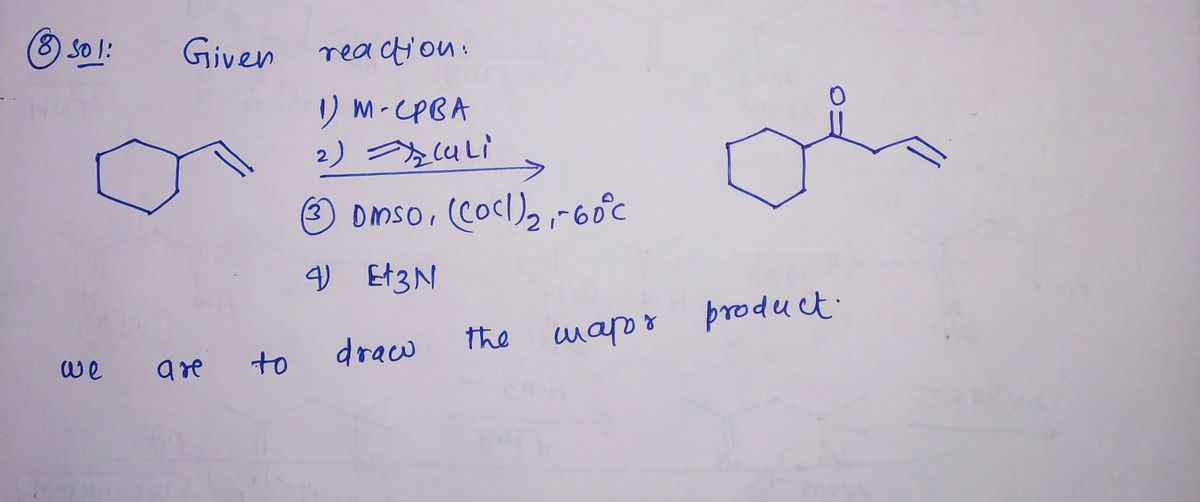Chemistry
10th Edition
ISBN:9781305957404
Author:Steven S. Zumdahl, Susan A. Zumdahl, Donald J. DeCoste
Publisher:Steven S. Zumdahl, Susan A. Zumdahl, Donald J. DeCoste
Chapter1: Chemical Foundations
Section: Chapter Questions
Problem 1RQ: Define and explain the differences between the following terms. a. law and theory b. theory and...
Related questions
Question
100%
Please write out the full mechanism with explanations on how to get the answer in red, thank you so much!
![**Multistep Synthesis Problem:**
**Objective: Predict the major product of the following multistep syntheses:**
**Starting Material:**
- Cyclohexene
**Reagents:**
1. mCPBA (meta-Chloroperoxybenzoic acid)
2. Vinyl cuprate (\[(CH\(_2\)=CH)CuLi]_2\])
3. DMSO (Dimethyl sulfoxide), (COCl)\(_2\), at -60 °C
4. Et\(_3\)N (Triethylamine)
**Product:**
- The major product of this reaction sequence is a ketone featuring a cyclohexyl group and a three-carbon chain with an alkene (double bond) at the end, shown in red.
**Explanation of Steps:**
1. **Epoxidation**: The starting cyclohexene undergoes epoxidation by mCPBA to form an epoxide.
2. **Nucleophilic Opening**: The vinyl cuprate opens the epoxide and attaches a vinyl group to the carbon.
3. **Swern Oxidation**: DMSO and (COCl)\(_2\) at -60 °C facilitate the conversion of the alcohol group to a ketone.
4. **Neutralization**: Triethylamine (Et\(_3\)N) neutralizes the reaction mixture.](/v2/_next/image?url=https%3A%2F%2Fcontent.bartleby.com%2Fqna-images%2Fquestion%2F056a6993-71d2-4612-9aa9-44f871e3169f%2Fda127f55-f3df-4566-9967-a7d6117fbb23%2Feks927h_processed.jpeg&w=3840&q=75)
Transcribed Image Text:**Multistep Synthesis Problem:**
**Objective: Predict the major product of the following multistep syntheses:**
**Starting Material:**
- Cyclohexene
**Reagents:**
1. mCPBA (meta-Chloroperoxybenzoic acid)
2. Vinyl cuprate (\[(CH\(_2\)=CH)CuLi]_2\])
3. DMSO (Dimethyl sulfoxide), (COCl)\(_2\), at -60 °C
4. Et\(_3\)N (Triethylamine)
**Product:**
- The major product of this reaction sequence is a ketone featuring a cyclohexyl group and a three-carbon chain with an alkene (double bond) at the end, shown in red.
**Explanation of Steps:**
1. **Epoxidation**: The starting cyclohexene undergoes epoxidation by mCPBA to form an epoxide.
2. **Nucleophilic Opening**: The vinyl cuprate opens the epoxide and attaches a vinyl group to the carbon.
3. **Swern Oxidation**: DMSO and (COCl)\(_2\) at -60 °C facilitate the conversion of the alcohol group to a ketone.
4. **Neutralization**: Triethylamine (Et\(_3\)N) neutralizes the reaction mixture.
Expert Solution
Step 1

Step by step
Solved in 2 steps with 2 images

Knowledge Booster
Learn more about
Need a deep-dive on the concept behind this application? Look no further. Learn more about this topic, chemistry and related others by exploring similar questions and additional content below.Recommended textbooks for you

Chemistry
Chemistry
ISBN:
9781305957404
Author:
Steven S. Zumdahl, Susan A. Zumdahl, Donald J. DeCoste
Publisher:
Cengage Learning

Chemistry
Chemistry
ISBN:
9781259911156
Author:
Raymond Chang Dr., Jason Overby Professor
Publisher:
McGraw-Hill Education

Principles of Instrumental Analysis
Chemistry
ISBN:
9781305577213
Author:
Douglas A. Skoog, F. James Holler, Stanley R. Crouch
Publisher:
Cengage Learning

Chemistry
Chemistry
ISBN:
9781305957404
Author:
Steven S. Zumdahl, Susan A. Zumdahl, Donald J. DeCoste
Publisher:
Cengage Learning

Chemistry
Chemistry
ISBN:
9781259911156
Author:
Raymond Chang Dr., Jason Overby Professor
Publisher:
McGraw-Hill Education

Principles of Instrumental Analysis
Chemistry
ISBN:
9781305577213
Author:
Douglas A. Skoog, F. James Holler, Stanley R. Crouch
Publisher:
Cengage Learning

Organic Chemistry
Chemistry
ISBN:
9780078021558
Author:
Janice Gorzynski Smith Dr.
Publisher:
McGraw-Hill Education

Chemistry: Principles and Reactions
Chemistry
ISBN:
9781305079373
Author:
William L. Masterton, Cecile N. Hurley
Publisher:
Cengage Learning

Elementary Principles of Chemical Processes, Bind…
Chemistry
ISBN:
9781118431221
Author:
Richard M. Felder, Ronald W. Rousseau, Lisa G. Bullard
Publisher:
WILEY